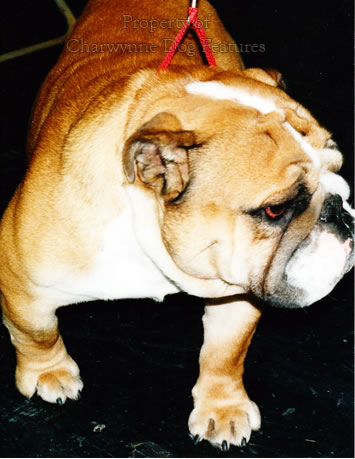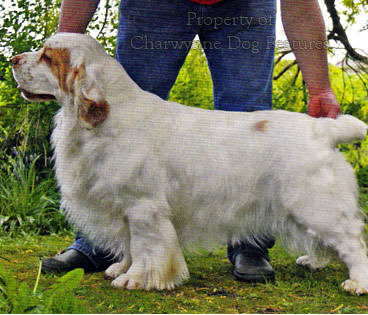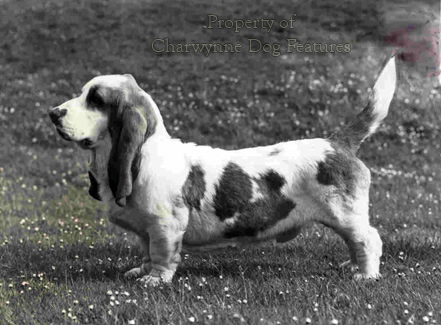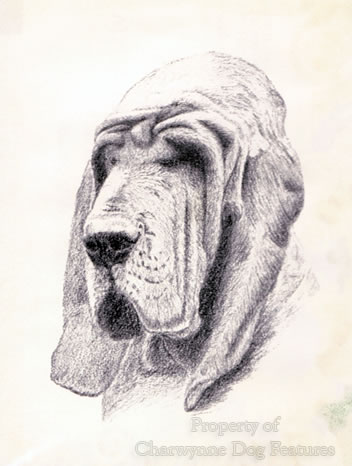727 PURIFYING PUREBRED DOGS
PURIFYING PUREBRED DOGS
by David Hancock
 These are difficult days for the pedigree dog in Britain. Entries for shows are down, far too many breeds are seriously affected by inherited defects and unprecedented numbers are being processed through the various rescue organisations. The number of dogs 'going into care' each year, that is straying or being unwanted by their owners is worrying. The number subsequently destroyed makes sad reading: 2,500 at Battersea Dogs' Home alone in the year 2000. Those destroyed there were out of a grand total of nearly 11,000 dogs received. In 1900, nearly 12,000 of the 16,730 dogs received were destroyed, a tribute to the rehoming system in place now. A surprising feature of the year 2000 statistics however is the number of pedigree dogs in that total.
These are difficult days for the pedigree dog in Britain. Entries for shows are down, far too many breeds are seriously affected by inherited defects and unprecedented numbers are being processed through the various rescue organisations. The number of dogs 'going into care' each year, that is straying or being unwanted by their owners is worrying. The number subsequently destroyed makes sad reading: 2,500 at Battersea Dogs' Home alone in the year 2000. Those destroyed there were out of a grand total of nearly 11,000 dogs received. In 1900, nearly 12,000 of the 16,730 dogs received were destroyed, a tribute to the rehoming system in place now. A surprising feature of the year 2000 statistics however is the number of pedigree dogs in that total.
A pedigree pup can cost from £500 to £1,000, depending on the breed, with an average of £750 being paid. Roughly half the dogs destroyed at Battersea were of a recognised breed. German Shepherd Dogs made up 7.6% of the entire intake and Staffordshire Bull Terriers comprised 7.9%. Of the 830 GSDs received 350 were destroyed. Of the 865 Staffies received 250 were destroyed. Also destroyed were 58 Rottweilers, 116 Jack Russells, 40 Cocker Spaniels and 36 West Highland White Terriers. Why are so many valuable dogs not only finding their way into a dogs' home but having to be euthanized?
Statistics from the rescue organisations, not just in Britain but abroad too, reveal that the biggest single reason for a dog being rehomed is temperament, usually unwanted aggression. Research tells us that the three major causes of bad temperament in dogs are: heredity, lack of socialization/upbringing and the individual dog's own nature, in that order. What do scientists tell us about the inheritance of temperament? The American vet Whitney crossed a Bull Terrier, regarded as a natural killer and fighter, with a placid Bloodhound. He found that two of the resultant pups, raised the same as the rest of the litter, possessed suspect temperament, one having to be destroyed because of its innate aggression. Another mating between a placid Bull Terrier and a Bloodhound produced no offspring with flawed temperament. Of the fourteen pups from these two matings only two had faulty temperaments, both from the aggressive Bull Terrier bitch.
Humphrey and Warner, in their 'Working Dogs' of 1934, showed that excessive timidity, which can lead to 'fear-biting', could be bred out. Bold confident dogs with controlled dominance have been found to be less likely to bite people than excessively timid dogs. The latter should never be bred from. The experiments of Kruskinsky indicated that excessive shyness increased markedly when two shy dogs were mated to each other. Shyness is dangerously underestimated by pedigree dog breeders; it so often comes from inadequate socialization, more likely in kennel bred dogs.
The distinguished canine behaviourist Michael W Fox, in his book 'Understanding your Dog' of 1974, wrote: "Too many breeders are selecting solely for conformation, for 'showy' or 'stylish' looks, which often become distorted, mimic exaggerations of the original breed standards. Insufficient attention is paid to selecting for stable temperament and for trainability and, consequently, many breeds are becoming suburban status symbols/ornaments, not companions." The Kennel Club will ban a dog from the show circuit, if it attempts to bite the judge, and deregister it. But it does not ban other dogs from the same breeding, surely also a risk. 
Puppy-farms, which often supply pet shops with pedigree pups, are a danger to the production of future family pets. Pups which have been left to starve spiritually in an outhouse from three to seven weeks of age will find the real world a frightening and daunting place. Young dogs allowed to become too dominant by being given the run of the house are also likely to pose problems. Predictably the foolishly drafted Dangerous Dogs Act of 1991 has targeted powerful dogs including specific breeds, but achieved nothing in reducing the bites inflicted annually by dogs.
The threat to pedigree dogs from breed-specific legislation is considerable, especially on mainland Europe and in North America. The Germans have legislated against all breeds of dog with 'bull' in their breed title, without resorting to any sound research. In America in some areas even Labradors are forbidden! A report of five years ago, based on a survey of accident and emergency ward statistics, revealed that the Borzoi was seven times more likely to bite someone than the much maligned Rottweiler! But most people bitten by dogs are not bitten by a pedigree dog but a mongrel.
Alongside temperament as a threat to pedigree breeds, although not so easily spotted, is the incidence of inheritable defects in breeds. These defects cause distress both to the dog and the owner, especially when a much-loved pet goes blind or dies young. Of course mongrels die from such causes but they have no club to oversee their welfare. Most breed clubs do not have a breed health survey on which to base programmes for breeding out defective genes, despite being encouraged to do so by the KC. Every pedigree dog is registered with the KC however and so much more could be done by them to reduce the incidence of inheritable diseases in pedigree stock.
Breeders of pedigree dogs have huge responsibilities in the campaign to reduce the suffering in dogs from inherited conditions. But the KC's control of the registry gives them ultimate power. Most of the world's more prominent kennel clubs now require health clearances for breeding stock -or the progeny cannot be registered. It is sad to read that the KC will ban a dog from the show ring after surgery for binary entropion, an inherited condition of the eyes, but still allow the dog to be bred from. Almost as sad is to see the KC, a national institution, so resentful of criticism or comment. 
In the Kennel Gazette of September 2001, in a column headed 'From Clarges Street', a member of the Kennel Club's staff writing in their own house magazine saw fit to object rather petulantly to a piece in 'Time' magazine on flawed dogs. This objection, needlessly defensively, took this tone: "The old 'chestnut' of breeders breeding unhealthy dogs has arisen once again - normally this story is limited to the period around Crufts but on this occasion the 'silly season' appears to have contributed to journalists having nothing better to write about." What extraordinary words from a member of staff of an organisation which only exists 'for the general improvement of dogs'. A riposte, well-argued and full of facts, would have been more valuable, more mature and more professional.
To dismiss concern about the breeding of unhealthy dogs as 'the old chestnut' is flippant and unworthy of such an organisation; are there really no unhealthy dogs being knowingly bred? On the day I read that Kennel Gazette, I had a letter from a lady striving very commendably to do her bit in breed rescue. She stated: "...breeders are not a lot of use on either subject (i.e. health surveys and breed rescue). Sorry, but it's true. Breeders will never admit they have any problem in their line." Who is more likely to know the true picture, someone behind a desk in Piccadilly or someone working away in breed rescue, year after year?
As for the words 'silly season' and 'journalists having nothing better to do', shame on the writer! What could be better than an international current affairs' magazine questioning the breeding of dogs without health clearances and to a faulty design? The 'silly season' will surely come when we stop raising such crucial issues of animal welfare. If the Kennel Club sees its role as defending breeders of purebred dogs however bad they are, then the sooner they change their self-imposed mandate of 'improving dogs' the better, if only for accuracy's sake. Responsibility should accompany authority in any organisation, if it wishes to be respected.
The Kennel Gazette writer continued: "It is difficult to know what more we can all do" and ends by describing the Dangerous Dogs Act as 'ill considered' when the KC was one of the bodies which drew it up. The silly season must have arrived outside Crufts time again! And why on earth is it difficult for the KC to know what more can be done? Here are two general points to start with; stop over-reacting to well-meant criticism, you lose stature each time you do, and, secondly, put some pace into your work, your committees are moribund. To improve dogs you have to be proactive not reactive, start leading!
Here are some specific points where the KC alone can enhance pedigree dog-care and dog-breeding. Do not allow any breed club or society to be registered with you unless they have a comprehensive health survey and an impressive breed rescue system. Far too many breed clubs don't give a damn about breed rescue or their breed's genetic health - and they get away with it. Unlike ours, kennel clubs from El Salvador to Croatia insist on health clearances for breeding stock or else the progeny are not permitted to be registered. Our purely reactive and rather lame Kennel Club has been overtaken in the field of improving purebred dogs. A glance at the Swedish Kennel Club's web site shows what can be done.
Every breeder of pedigree dogs in Sweden has to obey their KC's programme for genetic health or they cannot register their pups. Their kennels are inspected by their KC's own staff. A pup bought from a breeder registered with the Swedish KC comes permanently identified, with an approved contract of sale, a registration certificate and a health certificate dated less than a week earlier. Such a breeder has access to all the registrations made by the Swedish KC since 1970. Dogs with serious hereditary defects are not allowed to be used for breeding, unlike those in Britain. Instead of weakly croaking "what else can we do", our KC could start by emulating their Swedish counterparts. Before our KC moans that there are fewer dogs in Sweden, they might have the wit to realise that one of the reasons for this is that puppy-farmers wouldn't survive in Sweden.
Our KC has only recently agreed to amend breed standards which by their very wording help to create unsound unhealthy dogs. Here are just some of the words still in use: Bulldogs - 'Head Massive'. St Bernard - 'Head and skull, large, massive.' Newfoundland and Mastiff - 'Eyes, small.' Old English Sheepdog - '...a pear-shaped body when viewed from above.' Clumber Spaniel - 'Ideal weight, 80lbs.' Basset Hound - 'Hindquarters giving an almost spherical effect when viewed from rear.' Bloodhound - 'Head furnished with an amount of loose skin, which in nearly every position appears abundant.' Why on earth do we need massive-headed dogs, dogs with small eyes, pear-shaped sheepdogs, round-assed hounds or sporting spaniels weighing the best part of a hundredweight? Does the Bloodhound benefit from loose skin?
This design madness is perpetuated every year with the approval of our KC, and it is they who talk of a 'silly season'! And when well-intentioned critics speak up they are then attacked by the KC staff, no doubt still claiming a mandate for the 'general improvement of dogs'. The sadness of the current free-for-all is that bad breeders thrive and good breeders despair. If the KC spent as much time sitting down with the breed rescue people as they do discussing just the Crufts judging appointments, then our pedigree dogs would be better cared for, rather as they are in El Salvador and Croatia; oh and in Sweden, where the KC may lack a prestigious social club, but has the respect of every pedigree dog breeder in that country.
There are urgent problems to be faced in the pedigree dog world and important decisions to be made. Temperament simply has to receive a higher priority from breeders. It makes commercial sense as well as compassionate sense to breed stable dogs. Is a member of the public likely to buy your stock again if their last purchase from you bit their grandchild? Health surveys must be conducted if we are to trace carriers of inheritable diseases. It is now possible through gene therapy to give sight to a dog, blind from birth with congenital stationary night blindness, using cloned genes from healthy dogs. But how can you do that without breeding records that indicate the genetic health of the breeding stock? Compassionate breeders and responsible breed clubs should be nagging the KC on this, if only out of financial self-interest. Careless breeding costs lives!